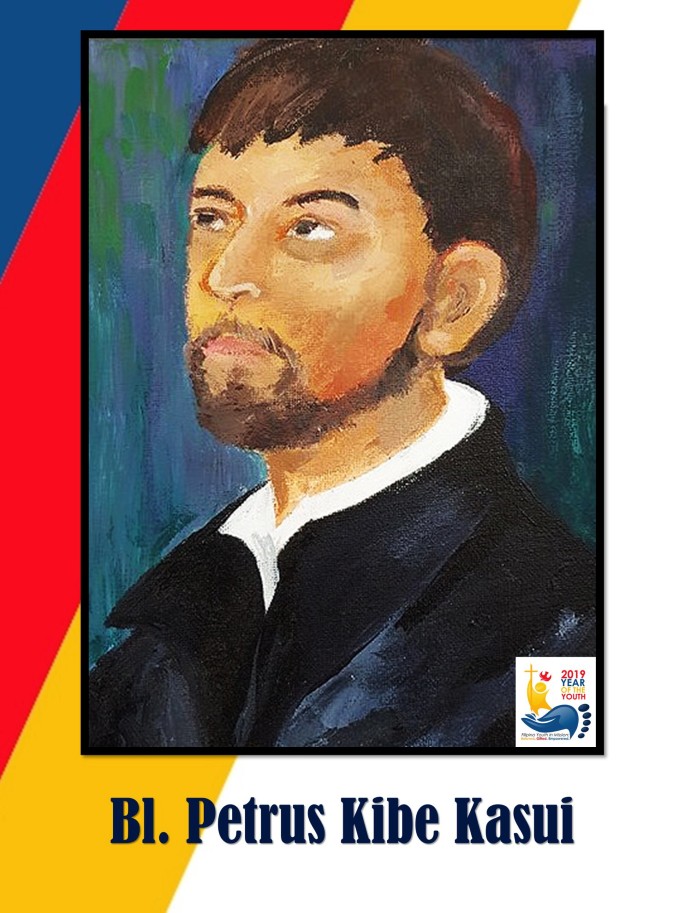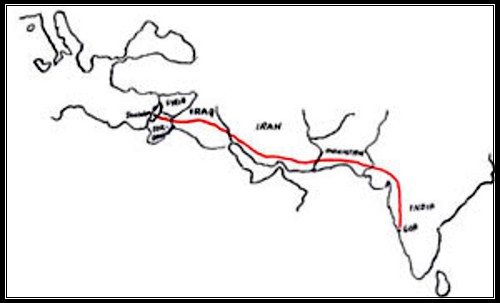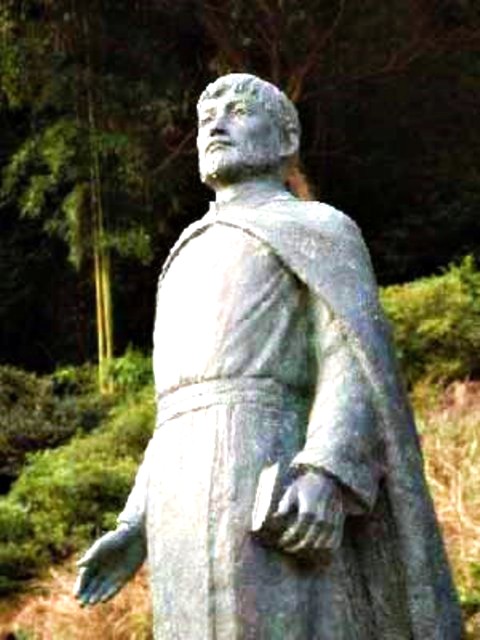Saint of the Day – 4 July – Blessed Petrus Kasui Kibe SJ (c 1587-1639) Japanese Jesuit Priest and Martyr. Born in c 1587 in Kibe, Oita, Japan and died by being run through with a spear on 4 July 1639 in Tokyo, Japan. He is called the “Japanese Marco Polo” or “A Christian Walking Through the World” and “The man who walked 4000kms.”
This is the extraordinary story of Fr Petrus Kibe who walked 4000kms to get permission to become a priest.
On 4 July 1639, Japanese samurai and Jesuit priest Father Petrus Kasui Kibe refused to renounce Christ under the most gruelling regime of torture ever devised by man or devil. In the wake of Father Petrus’ death, the Shogun’s master torturer dubbed him “the man who would not say, I give in”—a perfect epitaph to his heroic life.
He was the most international Japanese of his day, perhaps the most determined man on the planet and unflinchingly faithful to Christ unto death—and a most horrible death it was indeed. No wonder Peter Kibe’s name (pronounced KEE-beh) heads the list of the 188 Japanese Martyrs Beatified on 24 November 2008 by Pope Benedict XVI as Peter Kibe Kasui and 187 Companions, Martyrs.
The Kibes were samurai of Urabe in the province of Bungo on the island of Kyushu, a province which had been visited by Portuguese traders, six years before St Francis Xavier’s arrival in Kyushu on 15 Augus 1549—the Feast of the Assumption. Petrus was born in 1587, the year the dictator Hideyoshi first decreed a ban on Christianity, his parents, faithful Catholics, had their infant son Baptised in the Church at Nakatsu soon after his birth.
In 1600, Petrus entered the Jesuit Minor Seminary at Arima southeast of Nagasaki and on graduating, he declared his desire to enter the Society of Jesus. The Society wouldn’t open their doors to just any would-be Jesuit, though, they wanted solid proof of God’s call, so Petrus began eight years of humble labours as a Catechist until, in 1614, the de-facto Shogun Ieyasu expelled all Christian missionaries from Japan.
Petrus was shipped to the Portuguese colony of Macao, where the Society of Jesus was hard put to accommodate the huge influx of Japanese exiles. Some they sent to new Southeast Asian missions and others—like Petrus Kibe—they took in as Seminarians but they had to close their school in 1618, frustrating those men’s hopes for Ordination. Undaunted, Petrus and two other young samurai-missionaries set out for Rome, via India. The other two went on from India by sea but Petrus struck out on foot alone across Persia, heading for the Holy Land. Since he left us no record of his journey, we can only imagine the dangers he must have encountered along the way, traversing territory hostile to Christians, all the way to the Holy Land. That samurai grit of his, would march the stalwart Petrus Kibe all the way to Heaven, via the strait and narrow path of Martyrdom.
Having arrived in Rome with no proof on paper of his studies in Japan and Macao, he nevertheless conquered the churchmen’s doubts and on Sunday, 15 November 1620, he became Father Petrus Kibe by the laying-on of the Bishop’s hands in a chapel at the Lateran. When he showed up in his Cassock at the Jesuits’ door in Rome five days later, they didn’t turn him away, despite the Jesuit Visitor’s exhortations, written from Macao, to distrust wandering Japanese exiles like him – he won them over too and entered the Jesuit novitiate—normally lasting two years. For Father Petrus, though, two years was too long to wait – incoming reports of the ravening persecution in Japan would give him no peace – he must hurry to the aid of his countrymen. He petitioned the General of the Society of Jesus, who promptly agreed, Father Petrus’ mission was clearly ordained by God! He would leave Rome at once and finish his two years’ Novitiate en route to Japan.
He made his Jesuit vows in Lisbon on 21 November 1622 and the following March, on the Feast of the Annunciation, he set out on a trouble-plagued, fourteen-month voyage to India. Next he went on to Macao but the local government would let no Missionaries sail from their island to Japan, fearing the Shogun’s reprisals against Macao’s trade with his captive nation—the colony’s economic lifeline—so Petrus headed for Siam, hoping to sail on from there to his benighted homeland. On the way, his ship was chased by pirates in the Malacca Strait and everybody abandoned ship and swam for shore.
The Siamese royal capital of Ayutthaya had a large Japanese community, about 400 of them Catholic exiles. Some hundreds of these Japanese were ronin, or itinerant samurai, who served in the King’s Royal Guards. Petrus lived incognito among his countrymen in that exotic city for two years, trying to find passage to Japan but all Japan-bound ships’ captains were demanding oaths of apostasy of all Japanese-Christian would-be passengers, fearing the reprisals of the Shogun’s sheriff at Nagasaki—and Father Petrus would not deny Christ. After two years’ fruitless waiting, he sailed for Manila to try his luck there but the same rule held at Manila – no Missionaries could sail from there for Japan.
He and some other Japanese Christians—one of them a Priest like himself, Father Michael Matsuda—were determined to get to Japan somehow, anyhow, so they moved to a small island and there built their own boat. It was promptly attacked by termites. Undaunted, the intrepid believers plugged the holes with extra planking and, putting everything into God’s hands, set out for their beloved homeland.
It was the typhoon season of 1630 and they could have expected that their ramshackle, home-made boat would become a plaything of the tempests but they had almost made it to Japan, their dream was in sight, when a tempest came raging along and smashed their boat into the rocky shore of an island just off the coast of Kagoshima—the very place where Saint Francis Xavier had first set foot on Japanese soil to plant the Gospel seeds. Yet all in the shipwreck survived and the islanders not only gave them shelter but later ferried them on to Kagoshima after the storm had passed.
Now Father Petrus and his companions plunged into the fiery furnace that was the Shogun Iemitsu’s Japan. Father Petrus went north and for nine harried years, daily risking capture and the horrific torture that would inevitably follow, he offered the Body, Blood, Soul and Divinity of Jesus Christ for the starving souls of countless persecuted Christians; then, in July of 1639, he was caught and dragged before the wretched Shogun to testify for Jesus. The Shogun Iemitsu – paranoiac, pederast and sadist, this wretch, harboured a morbid fear of Christ and, according to the authoritative Japan-historian C R Boxer, he “derived considerable pleasure from cross-examining Christians under torture.”
The Shogun’s torture-masters were aiming for apostate priests, not dead ones and their method of persuasion was, by 1639, quite refined – the victim was cocooned in tight coils of rope and hung by his heels in a pit—probably containing human dung and other filth—his waist pinched in a clamp of sorts, a circular wooden lid cut in halves, with a hole in the middle for the pinched waist. This device both cut off the victim’s circulation and sealed the pit, shutting him in in that horrific stench; meanwhile, the torturers tempted him with promises of relief if only he would chant to Buddha and thus renounce Christ. All the while it felt like his head was exploding, while blood dripped from his mouth, ears and nose. On the day Petrus Kibe was given the treatment, two other priests were apparently induced under the same torture to chant the name of Amida Buddha and were hauled up and out, soon to die of their wounds—officially declared ‘apostates’ even though they had tried to recant their murmured chants before dying. Petrus, though, had been hung in another hole together with two Catechists and, ignoring his own agonies, he continually encouraged his brothers-in-suffering to cling to Christ to the end. Fearing the contagion of his faith, the executioners pulled him out and finished him off by burning firewood on his belly, according to one account, and since this didn’t kill the steely Father Petrus, they finally ripped out his bowels.
While Father Petrus was enduring his final torments, the Shogun’s torturers asked him why he didn’t just give in, and he told them, “You cannot understand this, therefore, it is no use guiding you.”
His guiding words they might not have understood but how Petrus Kibe’s living testimony—his superhuman faith—must have fired their hearts! A torch of truth still burning white-hot in this fourth century following his Martyrdom – proof of the blinding fact that God is real and that His Name is Jesus.
His interrogator was the infamous former Christian, Inoue. In his written deposition Inoue wrote, “Petrus Kibe has not fallen. He has also fortified his fellow prisoners. His sentence is death by strangulation.” Fr Petrus Kibe was executed in July 1639. He had run his race, finished the course and kept his faith. He had worked in Japan as a Priest for nine years. He was 52 when he died. Fr Petrus Kibe loved Christ, he loved his country and its culture, he loved his people . He was 100% Christian and 100% Japanese. He had the endurance Jesus spoke of. “You will be betrayed even by parents and brothers, relations and friends; and some of you will be put to death… but not a hair of your head will be lost. Your endurance will win you your lives” (Lk21:16-19).
Among the 188 martyrs beatified on 24 November were the following:
109 men – 32 samurai, seven catechists, one Jesuit brother and four priests.
49 women – 27 of whom died with their husbands.
30 children – from the age of one year to 14 years died with their parents.
“Though many were samurai and knew how to fight, they chose the path of non-violent resistance and that is significant for people today.” Cardinal Fumio Hamao.
The Beatification of Peter Kibe and 187 other martyrs took place on 24 November 2008, in Nagasaki. For the liturgical celebration in Nagasaki Stadium more than 30,000 participants attended, which was celebrated by Cardinal José Saraiva Martins on behalf of Pope Benedict XVI.

One thought on “Saint of the Day – 4 July – Blessed Petrus Kasui Kibe SJ (c 1587-1639) Priest and Martyr – “A Christian Walking Through the World””